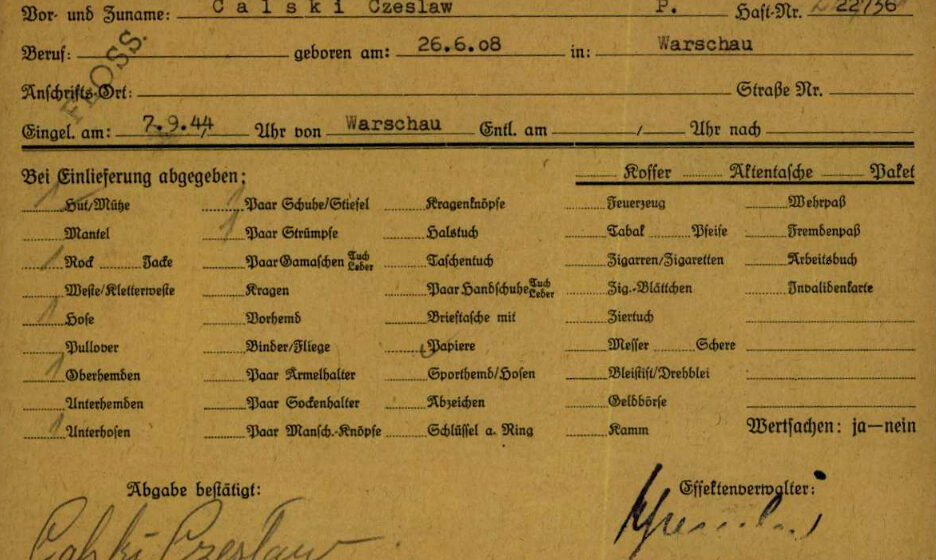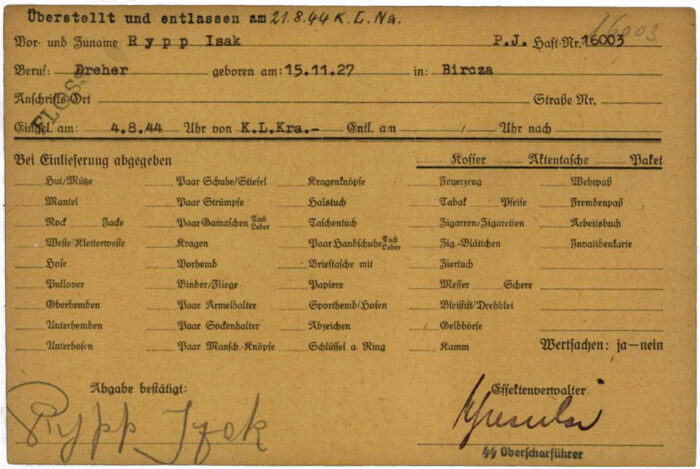New #everynamecounts partnership with Flossenbürg Memorial

The Arolsen Archives, together with a concentration camp memorial, are making a unique collection of documents on tens of thousands of victims of Nazi persecution accessible for the first time: The SS used personal effects cards to record important details about concentration camp prisoners – these were often the last vestiges of their lives. The collection from the Flossenbürg Concentration Camp is now available on the #everynamecounts crowdsourcing platform: Volunteers will digitize the information so it can be used by family members and for research and education purposes.
Many millions of original documents relating to victims of Nazi persecution from the Arolsen Archives are already available as digital scans. Anyone can view them in our online archive. However, in order to allow academics, students and the families of those persecuted to conduct in-depth and informative research, we need not only the documents themselves, but also all the information they contain in digital format. Thousands of volunteers are helping to make this happen through the #everynamecounts crowdsourcing initiative. They are processing millions of scanned documents and digitizing the details they contain.
Partnering with Flossenbürg Memorial
As of now, #everynamecounts has a new collection: Over 50,000 personal effects cards from the Flossenbürg Concentration Camp that are kept in the Arolsen Archives. These cards contain information about the paths of persecution of concentration camp prisoners which were often only recorded at this juncture. Both parties benefit from the #everynamecounts partnering: They can feed the digital information into their databases and provide new knowledge about paths of persecution and the prisoners from Flossenbürg.

»In this partnership, we are combining the knowledge of the Arolsen Archives and the Flossenbürg Memorial with the commitment of the #everynamecounts volunteers. Together, we are making new information about tens of thousands of concentration camp prisoners accessible. Memory today thrives on projects like this one.«
Floriane Azoulay, Director of the Arolsen Archives
What are personal effects cards?
The SS recorded all the belongings that people carried with them when they were arrested on these personal effects cards, from their clothing to jewelry, and letters. For researchers, there is even more information on these documents that is relevant: Occupations, places of birth and residence, prisoner categories (for example, “political,” “anti-social”), details of arrival or transfer to another concentration camp were recorded here. In some cases, they also show dates of death.

»By digitally capturing this information, we are creating a basis for further indexing and research projects. We are also enabling the analysis of large data collections using new digital humanities methods.«
Jörg Skriebeleit, Director of Flossenbürg Concentration Camp Memorial
Personal effects cards contain important information for family members
Personal effects cards are also extremely significant for the relatives of concentration camp prisoners who died during the course of their imprisonment: The prisoners had to sign these documents. These signatures are often the last personal token for their relatives. In many other cases, personal effects cards enable families to trace paths of persecution better. Sometimes they uncover details of other relatives of their family member who they didn’t even know.


Izok Rypp
… was only 15 years old when the Nazis deported him to the Jewish ghetto of Rzeszów (Poland) in 1942 for forced labor at a Daimler-Benz factory close by. Production came to a halt there in 1944 and the forced laborers were dragged from one concentration camp to another. The granddaughter of one of the victims has researched the fate of many individuals. The Allies liberated Izok from the Bergen-Belsen concentration camp. He died at a hospital in Hamburg on July 23, 1947.
#everynamecounts workshop at the Flossenbürg Memorial
To kick off the #everynamecounts partnership between the Arolsen Archives and the Flossenbürg Concentration Camp Memorial, 16 students from across Europe processed the first personal effects cards. They came together in April 2022 at an international youth meeting held by the Memorial and attended an #everynamecounts workshop. Staff at the Arolsen Archives and the Memorial introduced them to the project and supported the students while they carried out indexing work on the Zooniverse crowdsourcing platform.

The students from Russia, Ukraine, Italy, Turkey, Ireland, and Germany processed a large number of personal effects cards from the Flossenbürg Concentration Camp at the #everynamecounts workshop. (Photo: Flossenbürg Concentration Camp Memorial)


